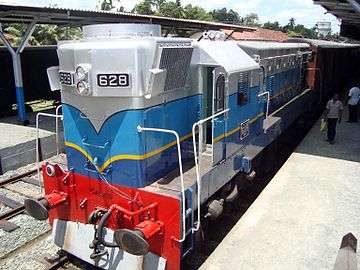CGR class H1
Ceylon Government Railways Class H1|
|
|
|
|
|
|
|
The CGR class H1 was a steam locomotive of the Garratt type built by Beyer, Peacock and Company for the Ceylon Government Railways (CGR), now Sri Lanka Railways. Only one locomotive was built and its CGR number was 293.[1]
Description
This steam locomotive entered to the service with CGR in 1931. This locomotive was used for working passenger and freight services in Udupussallawa railway. This locomotive met with a serious accident near Nuwara Eliya when it was hauling a freight train at excessive speed in 1942 and was silent for some years. In 1944 this was repaired and this was seen again in service. Up to 1960s, this locomotive was occasionally operated on Kelani Valley Line. In 1972 this was withdrawn from its service and was scrapped in 1981.[2]
See also
References
- ↑
- ↑ Rail 2000. Sri Lanka: Sri Lanka Railway. p. 42.
|
|---|
|
| Steam locomotives |
- A1
- A2
- A3
- B1
- B2
- B3
- B4
- B5
- B6
- B7
- B8
- B9
- B10
- C1
- D1
- D2
- D3
- E1
- F1
- F2
- F3
- H1^
- J1^
- J2^
- K1^
- L1^
| |
|---|
|
| Diesel-electric locomotives | |
|---|
|
| Diesel-hydraulic locomotives | |
|---|
|
| Steam railcars | |
|---|
|
| Diesel railcars | |
|---|
|
| Diesel multiple units | |
|---|
|
^ indicates narrow (2 ft 6 in/762 mm) gauge stock |
